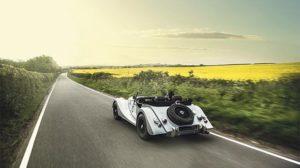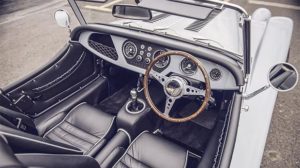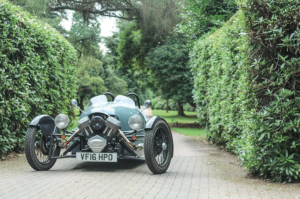Collectible Classic: 1961-’63 Morgan 4/4 Series IV Living in the past, for the foreseeable future (http://www.automobilemag.com)
By: Eric Weiner
Change is hard.
It’s human nature to cling to the familiar even as the world around you constantly shifts. But building cars is a sink-or-swim game, punishing the obsolescent to the watery grave of history. Then there’s Morgan. The quirky Malvern, U.K.-based outfit builds British man-of-wars compared to the advanced nuclear submarines on the road today, cobbling together wood-framed sports cars by hand the same way it has since the first four-wheeled Morgan hit the streets in 1936.
That first four-wheeler, the Morgan 4/4, has been in near-continuous production for 80 years. To this day it has remained a lightweight, open-top sports car with the engine up front sending power to the rear wheels with a hand-built ash body. Even for British sports car loyalists used to the quirky nature of Triumphs, MGs, and Healeys, driving a Morgan is an experience unto itself. Its combination of purity and oddity tends to attract people with a flair for the individual. My dad, Perry Weiner, is one of them.
“I wanted something fun I could just get out and drive; I liked that Morgans were different, something nobody else had,” he says of his 1963 Morgan 4/4. “And I couldn’t afford an E-type.” My dad bought the car in New Hope, Pennsylvania, in 1991 with 1-year-old me along for the ride. Over the years it would ferry me as well as my brother and sister (whichever of us was lucky that day) on countless Sunday drives and Morgan club meetups.
My dad reached out to the Morgan factory in England not long after his purchase and learned that his 4/4 was the final Series IV model in production, built December 17, 1962. The Series IV 4/4 started production in 1961, using a 1.3-liter four-cylinder engine shared with the Ford Classic. Power was up to 56 horsepower from the previous 39 in the Series III, but the biggest upgrade was the standard 11-inch front disc brakes. The original hood strap was lost, but the car still wears its original Old English White paint and red interior, as well as the optional strapless hood, tach-less dashboard, and oddball push/pull four-speed manual shifter.
Along with plenty of little dents and paint chips, the Weiner family Morgan has had quite a few patchwork adjustments over the years. For one, the original engine blew while climbing a hill in 1992, replaced by a 65-hp, 1.5-liter inline-four, which was also used in the Series V Morgan 4/4 and Ford Cortina. My dad had the cylinders bored out for a total of 1.6 liters of displacement, and he added a Weber downdraft carburetor to replace the original Zenith. Tired of dimming lights at stop signs, he swapped out the generator for an alternator. Then came the revamped cooling system with new radiator, fan, auxiliary fan, and self-designed aluminum shroud to funnel air into the system. He replaced the rear Armstrong Selectaride shocks with Konis, added Panasport wheels, and tore out the bench seating in favor of buckets he fashioned himself from plywood and rolled aluminum.
“No matter how much or little you do to a Morgan, it’s still a blast,” he says. “And it’s not part of a culture where purists will look down on you if every little nut and bolt isn’t correct. Everyone’s Morgan is unique, just as they were when they came from the factory.”
The wood-rimmed steering wheel, a 40th-anniversary gift from my mother, nicely matches the re-stained dashboard and refaced gauges.
Nothing makes you want to strap on a pair of goggles and leather gloves like driving a Morgan. With roughly 70 hp and a total weight of about 1,500 pounds, the car is positively alive in your hands. Exposed to the elements, with the hood stretching ahead and the road so close you could literally reach down and file your fingernails on it, a Morgan provides driving pleasure to every one of your senses. It also channels every road imperfection, riding stiffly with its live rear axle over potholes and eliciting a disconcerting squeak of the wood frame. The benefits far outweigh the drawbacks, though, with totally flat cornering and sensational steering feel from the unassisted Cam Gears box. “At its best the sense of speed is exhilarating, and at its worst it’s like driving a stagecoach over a rutted desert track,” my dad says.
Lately he’s been toying with the idea of restoring the car, although he’s worried that it would affect how often he’d drive it. A common strategy is to transplant all of the running gear onto a new tub and frame and take the opportunity to paint the body while it’s removed. He’s thinking of maybe painting it navy blue; I’m thinking of stealing it from the garage so he can’t. It would be like one of my siblings getting a face transplant. My childhood took place in that car. The 4/4 wasn’t perfect, but it evolved and hopefully improved as time went on, and we fixed the things that were broken. Then again, maybe I’m just clinging a little too tightly to the past. But isn’t that the point?
The Specs
Engine – 1.6L, OHV I-4; 70 hp @ 5,000 rpm (est), 85 lb-ft @ 2,300 rpm (est)
Transmission – 4-speed manual
Drive – Rear-wheel
Front Suspension – Sliding pillar, coil spring
Rear Suspension – Solid axle, semi-elliptic springs
Brakes F/R – Discs/drums
Weight 1,500 lb (est)
The Info
Years Produced 1961-1963
Number Sold – 202
Original Price – $2,394 (1963)
Value Today – $27,900*

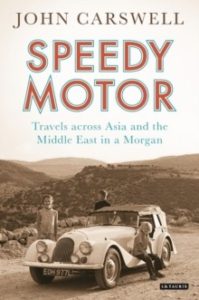 In the summer of 1974, against the backdrop of the Lebanese Civil War, ceramics expert and Morgan sports car enthusiast John Carswell set off with his young family from their home in Beirut on an expedition across Asia and the Middle East.
In the summer of 1974, against the backdrop of the Lebanese Civil War, ceramics expert and Morgan sports car enthusiast John Carswell set off with his young family from their home in Beirut on an expedition across Asia and the Middle East.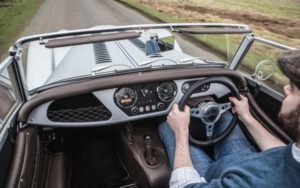
 This exciting new vehicle is aimed at children aged 6 years and over. The EV Junior is a fully electric replica of the EV3 and is capable of 16kph. Each unit will be bespoke built to order with flexible colour and trim levels. Prices start at £6,662.50 + VAT
This exciting new vehicle is aimed at children aged 6 years and over. The EV Junior is a fully electric replica of the EV3 and is capable of 16kph. Each unit will be bespoke built to order with flexible colour and trim levels. Prices start at £6,662.50 + VAT